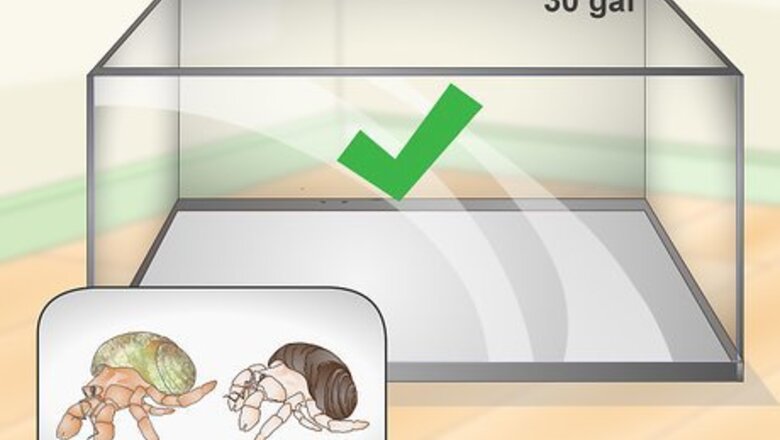
views
Creating a Play-Friendly Environment
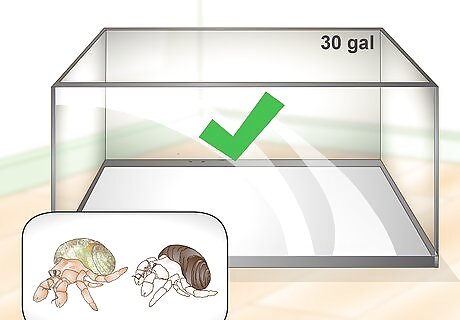
Get a 30 US gal (110 L) tank for 2 medium-sized hermit crabs. Your hermit crab’s tank should be at least 30 gallons (110 L) if the crabs are medium-sized. However, if you just have a couple of very small crabs, then you can start with a 10 US gal (38 L) tank and upgrade as the crabs grow. This size tank will ensure that the crabs have plenty of room to play. A solid glass or plastic tank is essential for keeping moisture in and maintaining a humid environment. Never try to keep hermit crabs in a wire cage.
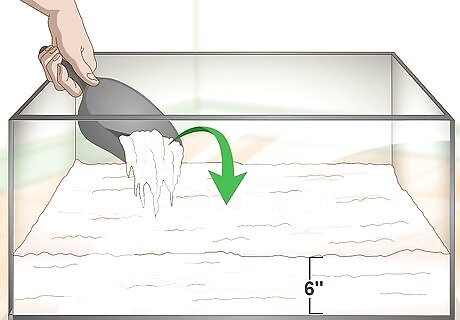
Fill the bottom of the enclosure with 6 inches (15 cm) of sand. Hermit crabs love to burrow and dig, so provide a thick bed of sand. This will help to ensure that your hermit crab has plenty of room to dig and play in the sand. Coconut fiber is an acceptable substitute for sand, or you could even use a 50-50 mixture of coconut fiber and sand. Make sure that the sand is dry and clean. You can purchase sand at a pet supply store, use hardware store sand, or get sand at the beach.

Place 2 shallow dishes of de-chlorinated water in the enclosure. Hermit crabs need to be able to soak in water, so get 2 dishes that are large enough for your hermit crab to get into. Fill them up with enough water to reach the hermit crab's shell. If the dishes have high sides, you can submerge them in the sand and place a layer of rocks into the bottom of the dishes to make it easier for your hermit crab to get in and out of them. Keep 1 dish filled with fresh water and the other 1 with salt water. Dechlorinated water is essential because chlorinated water can harm the crabs. You can dechlorinate the water using a dechlorinating device available at pet stores. Purchase salt water from an aquarium store. Avoid putting table salt in the water, as it is poisonous to hermit crabs.
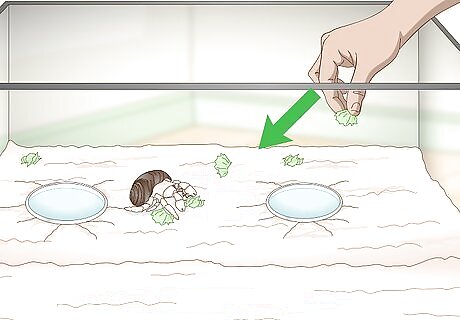
Scatter your hermit crab’s food around its enclosure for stimulation. Instead of placing your hermit crab’s food in the same place day after day, you might consider scattering it around so that the crab has to forage for it. This can be a fun game for your hermit crab! Sprinkle the food around the enclosure at random. You could even place some up on a branch or rock so your hermit crab has to climb to get it. Hermit crabs can eat a variety of veggies, fruits, nuts, and grains, and you can scatter any of these foods around the enclosure.
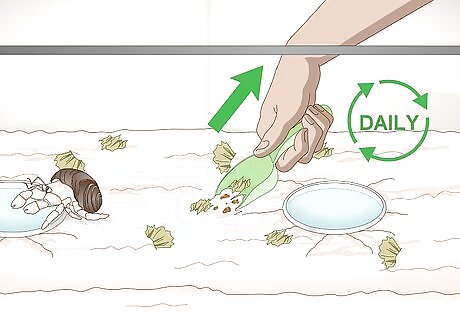
Clean your hermit crab’s enclosure daily. Scoop out droppings and any uneaten food daily to ensure that your hermit crab’s environment stays clean. This will make it easier for your hermit crab to roam and play in the enclosure without encountering any waste or rotten food. To keep the tank clean, you must do daily maintenance and also change the sand on a monthly basis.
Adding Enrichment Items to Your Hermit Crab’s Habitat
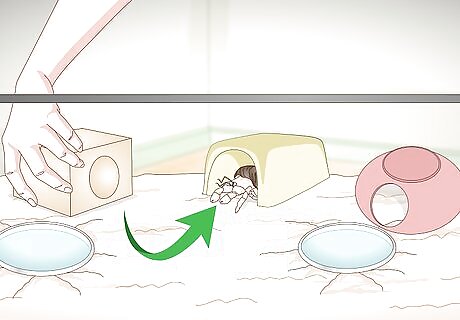
Place hiding spaces throughout the enclosure to provide safe spaces. Hermit crabs like to retreat to dark, enclosed areas sometimes. This makes them feel safe and allows them to relax. To ensure that your hermit crab will be able to retreat when it needs a break from playtime, put several hiding spots in the enclosure. Some examples of enclosures include: Small boxes with holes cut in 1 or 2 sides of them. Empty flower pots turned on their sides. Hollowed out logs or rocks (available in pet stores). Ceramic castles and other types of manmade hiding spots sold at pet stores.
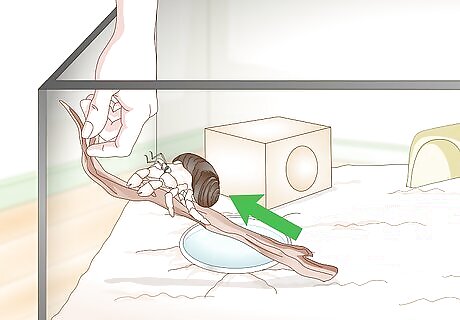
Lean a piece of driftwood against the side of the enclosure for climbing. Hermit crabs like to climb, so make sure to include 1 or more driftwood branches. You can get a driftwood branch by searching around on a beach or you can purchase a driftwood branch from a pet supply store. Driftwood is a great option since hermit crabs usually live by the sea. Pet stores also carry fake driftwood branches for use in hermit crab enclosures.
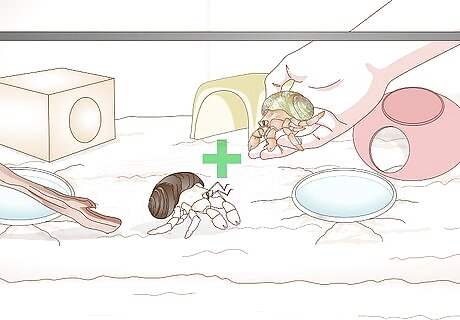
House your hermit crab with 1 or more other hermit crabs for company. Hermit crabs are social creatures, even though their names indicate they prefer to be alone. If possible, keep hermit crabs in pairs or in groups. If you only have 1 hermit crab, consider getting another 1 to keep it company. After getting a new hermit crab, make sure to keep it separate from your other crabs for 1 week to make sure it is healthy.
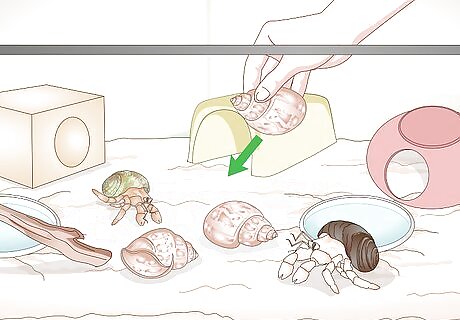
Provide several different sized shells to allow your hermit crab to grow. A hermit crab needs to move into a larger shell whenever it outgrows its current shell. Make sure that you provide your hermit crab with other shell options for when it has outgrown 1 shell. It is also important to provide lots of shell options to prevent your hermit crabs from fighting.
Handling Your Hermit Crab
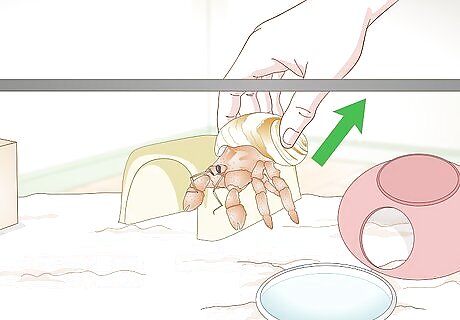
Pick up your hermit crab by the shell. To give your hermit crab time outside of its enclosure, you will need to pick it up and place it somewhere safe. Grasp your hermit crab firmly around its shell when you pick it up. Do not grasp its body because it is likely to pinch you and you may also injure it in the process. Keep in mind that it is best not to handle your hermit crab too often. They do not like to be touched.
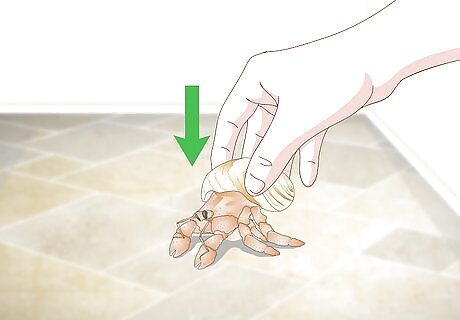
Place the hermit crab on the ground gently. Never place a hermit crab on a table or chair when you want to let it roam. Your hermit crab’s vision is not as good as yours, so it might not be able to tell where the surface of a table or other surface ends. This could lead to your hermit crab falling and getting injured.
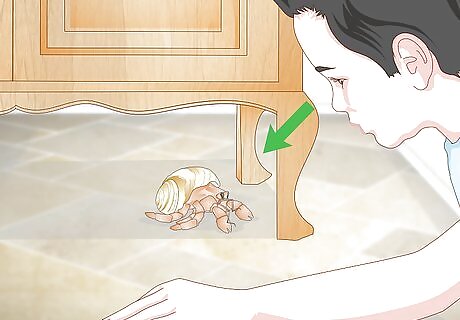
Supervise your hermit crab while it roams and explores. To keep your hermit crab safe, make sure that you keep a close eye on it the entire time it is out of its enclosure. Prevent it from crawling into tight spaces, falling down stairs, or getting into other dangerous situations. If you are in your bedroom, close the door to help keep your hermit crab contained. Your hermit crab will need to eat, drink, sleep, and defecate at some point, so don’t keep it out for more than 1 hour.

Don’t remove your hermit crab from its shell or pull on its limbs. Never pull your hermit crab out of its shell and never pull it away from something it is clinging to. This may cause the hermit crab to lose 1 or more of its limbs. Even though the hermit crab’s limbs may grow back, it may be too injured to survive.















Comments
0 comment